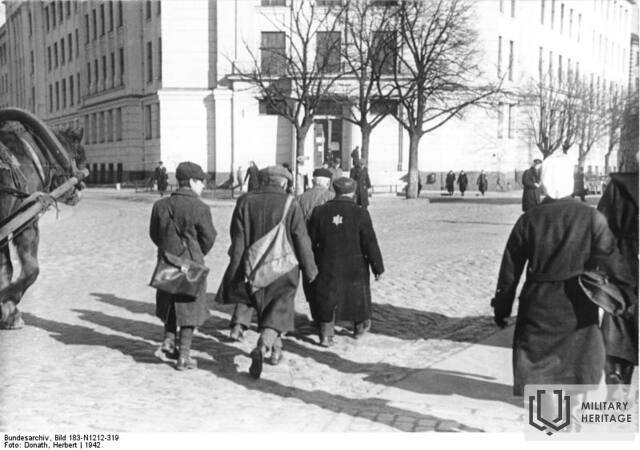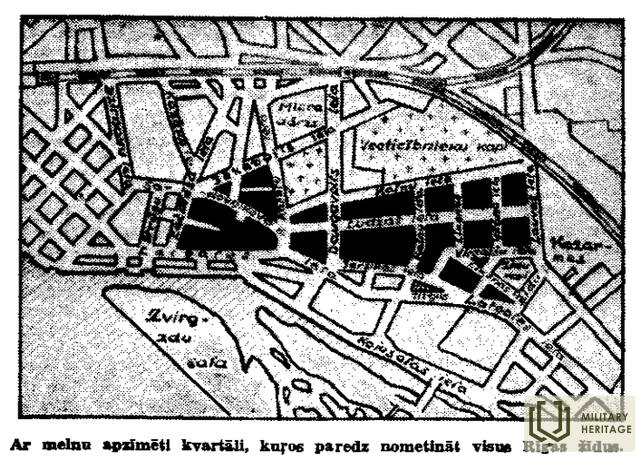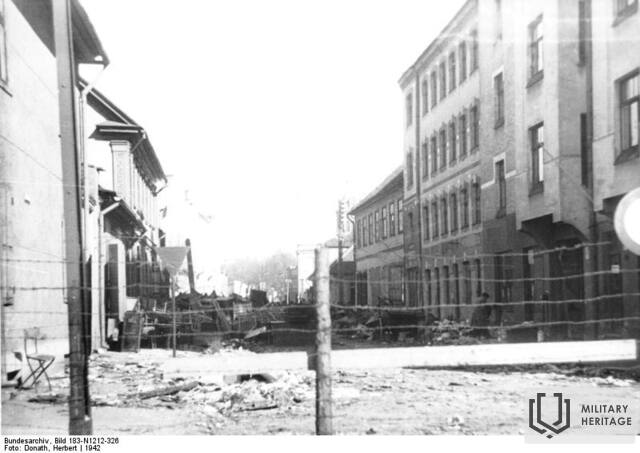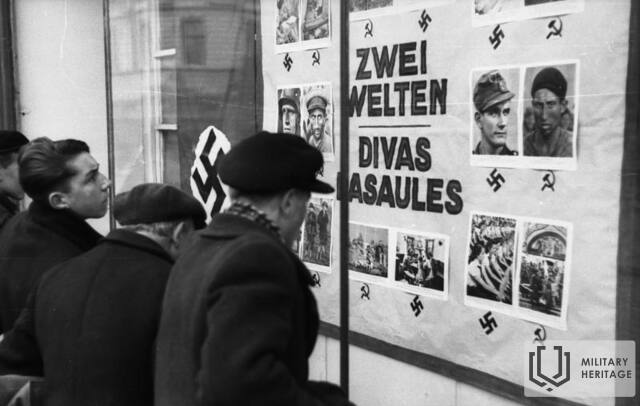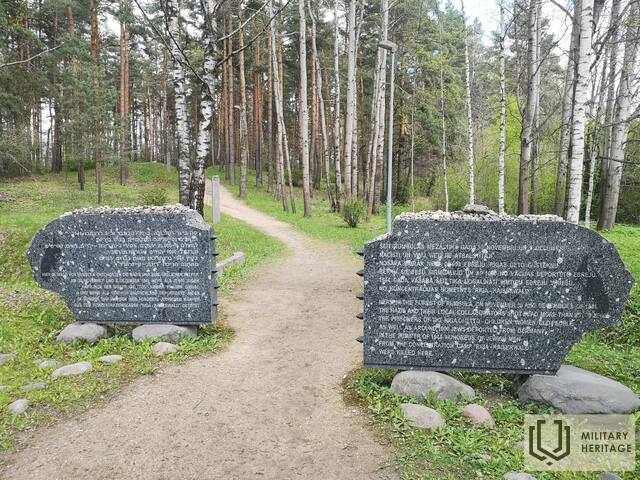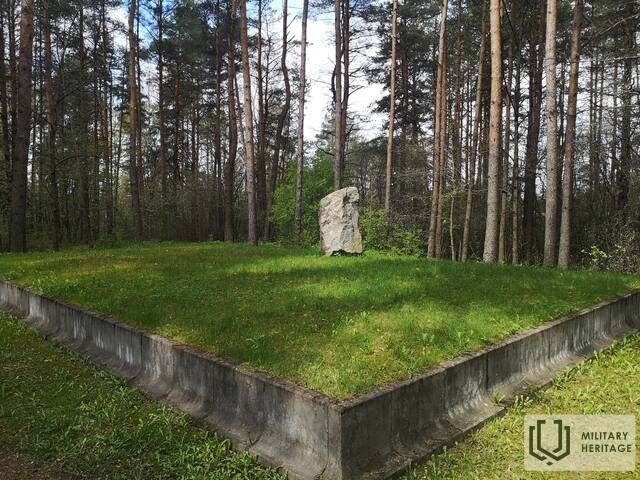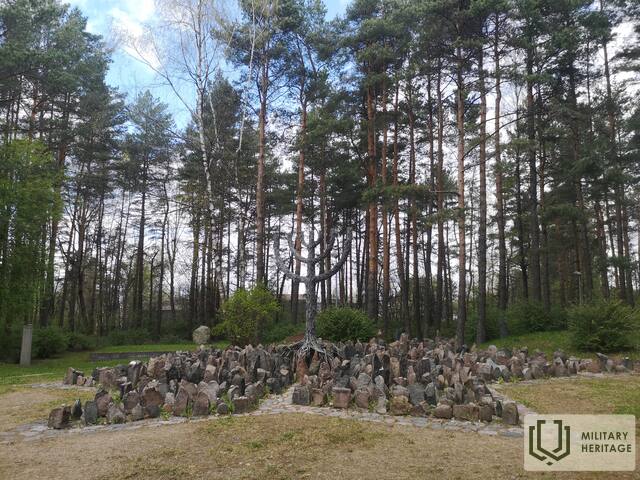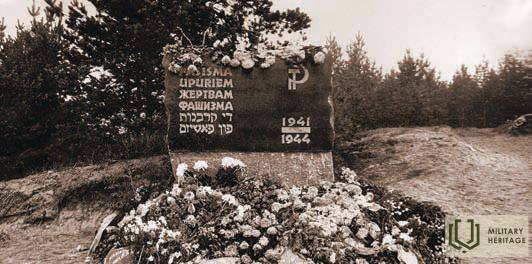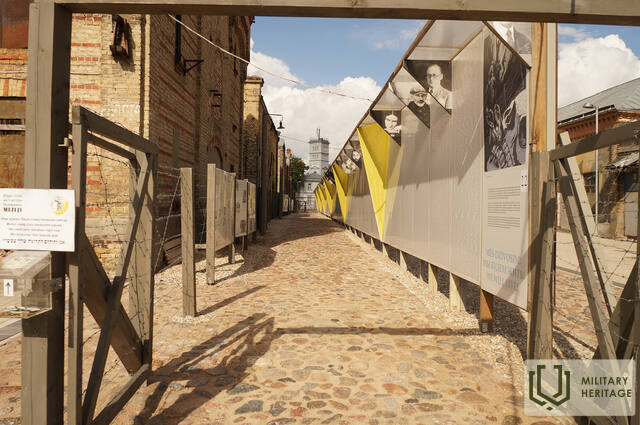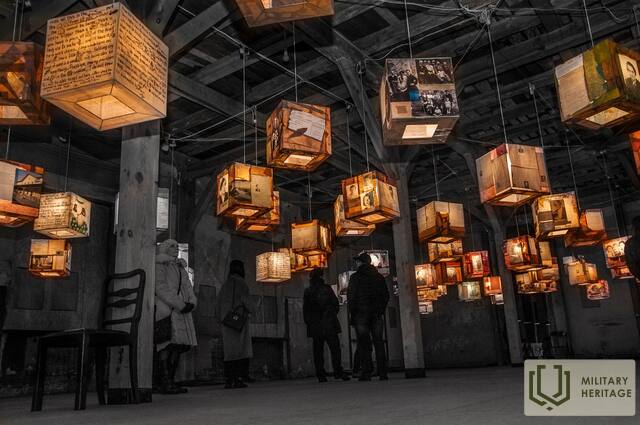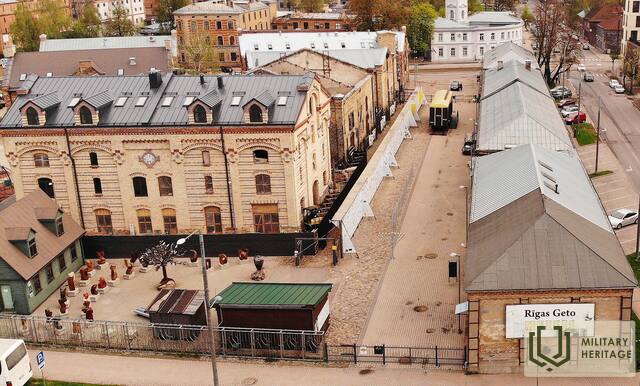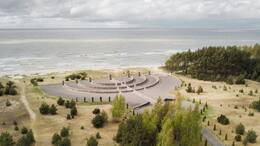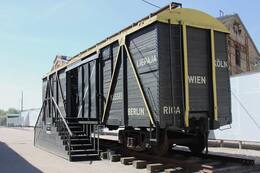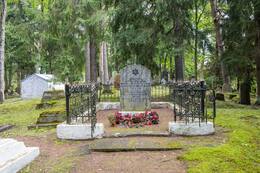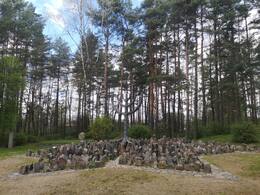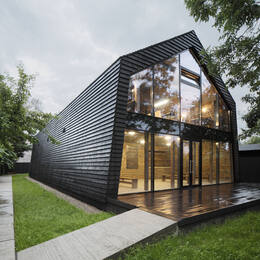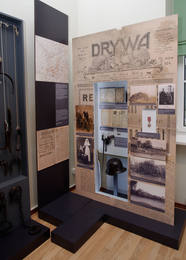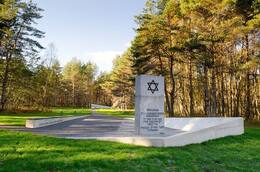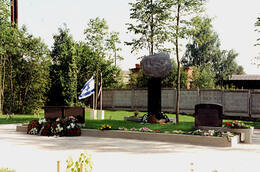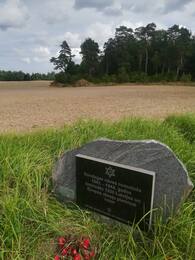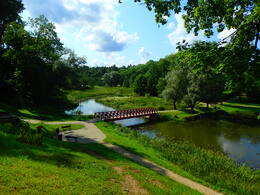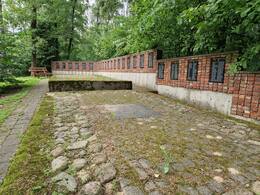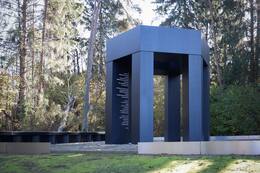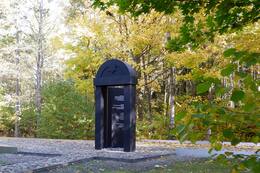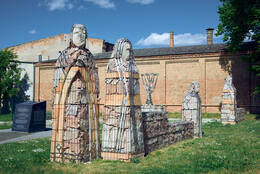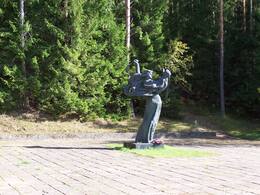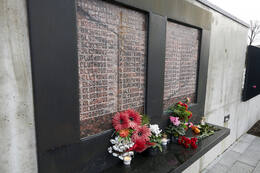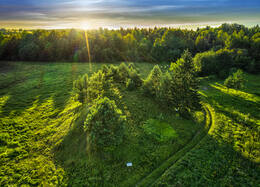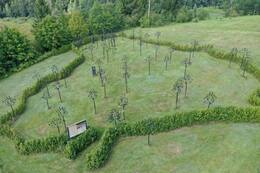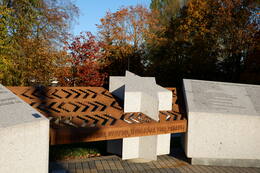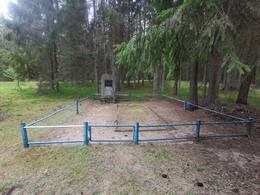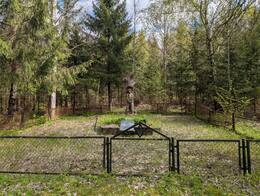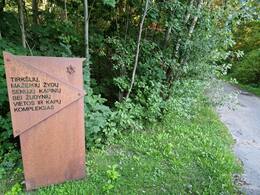The Holocaust II WW2
The Holocaust (Greek holos - all, no remnants; burned in caustics) - the mass extermination of Jews in Nazi Germany and its occupied territories during World War II. The process of mass extermination of the Jews began with the Polish occupation. With the German invasion of the Soviet Union on June 22, 1941, the active phase of the Holocaust began. The Nazi secret so-called "final solution to the Jewish question" (Endlösung der Judenfrage) was intended to kill all Jews living in the USSR. In the second half of the 1930s, 93,479 Jews lived in Latvia (1935). The majority of German, Austrian, Hungarian and Czechoslovak Jews deported here during the war were also killed in Latvia. Genocide was also directed against the Roma and the mentally ill in Latvia. The Holocaust is the largest mass crime committed against the civilian population in the history of Latvia - approximately 73,000 Latvian Jews and 16,000 foreign Jews perished during the Nazi occupation.
The implementation of the Holocaust in German-occupied Latvia was initially carried out by the German security police and the SD special unit Einsatzgruppe A, the largest of the four such einzac groups. It was led by SS Brigadier General and Police Major General Walter Stahlecker. At first, various restrictions and prohibitions were introduced, followed by the registration of Jews, who were required to wear the symbol of Judaism, the six-pointed Star of David. The Jews were confiscated from their property, followed by their isolation and eventual murder. The first murders took place on June 23, 1941 in Grobiņa. The German military and civilian authorities needed to establish their power and involve the local population in the killings. They took place in all settlements with a small Jewish population. The main perpetrators of the killings were specially formed SD units under the leadership of Viktors Arājs and Mārtiņš Vagulāns.
Judas cult buildings - synagogues - were burned down. the second half of the choral synagogue on Gogoļa Street. On August 23, a ghetto was established in the suburbs of Moscow, healing 29,602 people. 14,000 ghettos were placed in the Daugavpils ghetto, and several thousand in the Liepaja ghetto. On November 30 and December 8, 1941, about 25,000 Jews brought from Latvia and 1,000 from Germany were killed under his leadership in Rumbula. Some 6,000 Jews were forced to live after the Rumbula massacre. In 1944, the survivors were deported to camps in Germany. The German Nazi occupation authorities also carried out genocide against members of the Latvian Roma (Roma) and the mentally ill. Approximately 2,000 Roma were killed in several Latvian cities, in psychiatric hospitals in Riga, Daugavpils, Liepaja, Strenči, etc. - approximately 2,327 people.
More information sources
http://okupacijasmuzejs.lv/lv/aktualitates/4-julijs--ebreju-tautas-genocida-upuru-pieminas-diena-379/
Related objects
Memorial to the victims of holocaust in Liepāja
The largest memorial to Holocaust victims in Latvia is located in Liepāja, in the Šķēde dunes. The memorial is dedicated to the memory of more than 3,000 Liepāja Jews killed during World War II. It is in the form of the Israeli national symbol, a seven-branched candelabra known as the menorah. The contours of the memorial, which are clearly visible from a bird’s eye view, are made of split boulders and granite blocks. The ‘lights’ of the menorah are made of granite pillars with inscriptions of verses from the Lamentations of Jeremiah in Hebrew, English, Latvian and Russian.
Riga Ghetto and Latvian Holocaust Museum
The Riga Ghetto and the Latvian Holocaust Museum is located in Riga close to the Riga Central Market and the Riga Central Station. The museum was opened in 2010 on the site where the city's warehouses once were. It is located in the historical part of the city, next to the border of the former Jewish ghetto. The territory of the ghetto is unique, because in terms of architecture it has not changed since World War II. It is a memorial dedicated to the tragedy suffered by the Jewish people. The German policy regarding the Jewish population in Latvia until the end of 1939 was for the German diplomats and politicians to try and pressure the Latvian government to take action against the Jews by restricting their freedom. After the emigration of the Baltic Germans in 1939, the German embassy no longer had as good an access to information on the mood of the population and the events happening in Latvia as before. When the Red Army occupied Latvia, they manipulated the society to gain some support of the Jewish population for the new occupying power. However, after the regime started a crackdown on the society as a whole, the support fell rapidly. As a result of all this, a deep divide had formed between the people. And later on, the next regime – Germany – tried to exploit it. They hoped that the local population would harass and attack the Jews, but that did not happen. So, Germany adjusted their approach and devised a new plan to initially establish a Jewish ghetto and later destroy its inhabitants.
Varaklani Jewish Cemetery - a memorial to the victims of German-fascist terror
Varakļāni Jewish Cemetery, at the end of Kapsētas Street.
There are two monuments erected in the Varakļāni Jewish cemetery after the war by surviving relatives and relatives.
One of them is located near the cemetery fence, where the mass extermination of Jews took place. The inscription on it in Russian and Yiddish reads: "We will mourn forever with our parents, brothers and sisters who died at the hands of the fascists in 1941." The second monument is inside the cemetery; In the place where the killed Jews were later reburied, there is also an inscription in Yiddish and Russian: "Eternal memory of the victims of the German-fascist terror - the Jews of Varakļāni, brutally killed on August 4, 1941".
Nazi German troops entered Varaklani in 1941. In early July, and from the very first days, the siege and isolated killings of Jews began. A conditional ghetto was established near the Jewish cemetery, to which all Jews had to move. On August 4, a German SD unit (the "Arāja team") shot virtually all Jews in Varakļāni (about 540 people) with the help of local self-defense forces on the territory of the Jewish cemetery.
Every year on the first Sunday of August, a memorial event dedicated to the Jews killed in Varakļāni takes place in the Varakļāni Jewish Cemetery.
Jewish Memorial at Rumbula
Located in Rumbula, near Moskava Street.
Rumbula is one of the largest sites of mass extermination of Jews in Europe. During two actions - 1941. On November 30 and December 8, which were realized based on the Nazi leadership's decision to completely exterminate the Jews imprisoned in the Riga ghetto, more than 25,000 people were shot in the Rumbula forest, including approximately 1,000 Jews deported from Germany. 1944 Several hundred Jewish men from the Kaiserwald concentration camp were also killed in Rumbula.
The first attempts to perpetuate the memory of the Jews killed in Rumbula date back to the end of the 60s. Despite the restrictions of the Soviet government, as a result of the initiative of some Jews in 1963. a wooden commemorative plaque with an inscription in Yiddish was attached to one of Rumbula's pine trees, while a large poster of the artist Josif Kuzkovskis "The Jew" was installed near the Rumbula railway (near the Riga-Moscow line). The poster showed the image of a man rising from the grave with a clenched fist, symbolizing a protest against what had been done. Both the commemorative plaque and the poster already in 1964. were harvested, but the Jews managed to obtain permission to erect a memorial stone in Rumbula with the inscription "Victims of Fascism" not only in Latvian and Russian, but also in Yiddish.
in 2002 On November 29, the memorial ensemble was opened in Rumbula according to the project of architect Sergejs Riž. Its establishment was financially supported by the institutions of Latvia, Israel, the USA and Germany, as well as private individuals.
On the side of the highway, by the road that leads to the memorial, a metal structure symbolizing the forces of Nazism has been installed as a sign. Nearby is a stone with the explanation that thousands of Jews were chased to death along this road. At the entrance to the memorial itself, several stone plaques with inscriptions in Latvian, English, German and Hebrew introduce the events of the Rumbula tragedy and the history of the establishment of the memorial. In the central part of the memorial, above the square, which is made in the shape of the Star of David, rises a seven-branched candlestick - a menorah, surrounded by stones with engraved names of the Jews killed in Rumbula. The names of the streets of the former Riga ghetto are engraved in individual stones with which the square is paved. There are several mass graves on the territory of the memorial, the places of which are marked with rectangular concrete borders.
Žanis Lipke Memorial
The Žanis Lipke memorial is located in Ķīpsala, Riga. The Žanis Lipke Museum is probably one of the most hidden museums in Riga. The obscure location of the memorial is not a coincidence and it has a symbolic meaning. It has been set up in the location of a former underground hideout that was created to save people during the German occupation of World War II. Here Žanis Lipke and his family rescued 55 Jews. Nowadays a memorial has been built next to the Žanis Lipke family house. The memorial ‘Black Shed’ is a symbolic building where shelter was provided and received. The design of the building has been taken from the historical tarred huts of Ķīpsala fishermen and sailors. These huts were built using materials from barges; hence they had a very distinct colour and tar smell. But not only the story of this historic place is unique. The way the museum communicates its message is also quite notable. The overall design has similarities with the Noah’s Ark described in the Bible, and it also resembles a boat that has been pulled ashore and overturned – a boat that has fulfilled its task. The concept of this memorial draws from the historic accuracy of this place and story and the testimonies associated with it. It is a story of a desire for freedom, unbelievable escape and trust. On your way to the museum, you’ll also be able to see the historic buildings of Pārdaugava.
Preiļi Museum of History and Applied Art exhibition "Museum stories for Latvia"
It is located in the premises of the Preiļi Cultural Center.
Preiļi Museum of History and Applied Art (PVLMM) exhibition "Museum stories for Latvia" about the First World War, the War of Independence and the Second World War can be viewed.
The "Story of Drywys" section of the exhibition "Museum Stories for Latvia" (opened in 2018) of the Museum of Preiļi History and Applied Arts is dedicated to the First World War, the War of Independence and the liberation of Latgale, as well as to the knights of the Lāčplešana War Order. The exhibition section "The story of the flag" tells about the difficult events of the Second World War period, during which the people of Preila were affected by deportations, the Holocaust, involvement in the military units of the warring parties, and after the war - in the ranks of national partisans. The "Righteous Among the Nations" medal awarded to Vladislav Vuškānas, the savior of the Jews from Preiliat, can also be viewed.
Upon prior application, a tour is available in Russian and English.
Klooga Concentration Camp and Holocaust Memorial
This memorial to the victims of the Holocaust is situated not far from the small borough of Klooga.
The first monument was erected here in 1951, but it essentially praised the Soviet ideology and did little to commemorate the victims of the Holocaust. In 1994, the plaques on the monument were replaced with new ones at the request of the Jewish community in Estonia so as to do justice to the victims' ethnic roots. On the 50th anniversary of the mass murder perpetrated in Klooga, a monument to the Jews killed in Estonia from 1941-1944 was unveiled 100 metres from the first monument. In 2005, a third monument was unveiled commemorating the Jews who died or were killed in the concentration camp in Klooga.
The memorial was renovated in 2013 to tie the three monuments together, with the Estonian History Museum opening an outdoor exhibition here entitled ‘Klooga camp and the Holocaust’.
Klooga concentration camp was established by the German regime in September 1943. It was a forced-labour sub-camp of the Vaivara concentration camp complex in Estonia. On 19 September 1944, one of the largest mass murders in German-occupied Estonia was committed: all of the Jews at the camp (around 2000 in total) were killed as the Red Army approached.
Preilius Holocaust Memorial
It is located in the Preiļu Jewish cemetery on Cēsu street.
The architect of the memorial is Sergejs Rizh. Opened on August 8, 2004. The memorial was built on the initiative and personal funds of Dāvid Zilbermanis (USA), a former resident of Preiļi, engineer and public worker. In 2015, another monument was added to the memorial - an arch installed at the entrance to the cemetery in the form of a symbolic gate.
The memorial is located on the edge of the Preiļi Jewish cemetery, next to the place where around 800 Jews from Preiļi and the surrounding area were killed in the summer of 1941 after the entry of Nazi German troops with the involvement of local collaborators. The diary of Sheina Gram (1926-1941), a Jewish girl from Preiļi, which she started writing on June 22 - the day the war between the USSR and Germany started - until August 8, is a testimony of the events of this time. Sheina, together with her family and other surviving Jews of Preila, was killed next to the Jewish cemetery on August 9. Thanks to the help of Vladislav Vuškānas (1887-1953) from Preili, 6 Jews from Preili managed to survive the German occupation in hiding. On the stones of the monument are engraved entries from Sheina Gram's diary, as well as words of gratitude to the savior of the Jews, Vladislav Vushkan. An urn with the names of the 750 Jews killed here is buried at the foot of the monument.
Misiņkalns Military Heritage Trail
Misiņkalns nature park is located in the town of Aizpute. Misiņkalns is the highest place in the city of Aizpute. Its height reaches 95.4 m. The top offers a scenic view of the city. Misiņkalns nature park was started to be built in the 20th century. at first. The area of the park is currently about 28 ha.
In the territory of the park there are several places and memorials related to the events of the 20th century - the memorial stele of the soldiers who died in the Latvian Freedom Wars - the cavaliers of the Lāčpleš Order, the place of the Holocaust memorial, the place of remembrance of the repressed and the memorial plaque of the fallen red partisans.
In the park, you can get to know the plants and plantations of various rare species, as well as enjoy the untouched nature. Currently, the park is criss-crossed by renovated walking and cycling paths, and there is a motorcycle track on the territory of the park, where Latvian motocross competitions take place.
In order to get to know the cultural and historical heritage of Misiņkalns manor park more fully, we recommend using the services of a guide.
Holocaust reburial site
Nazi troops entered Aizpute in 1941. on June 28. Already at the beginning of July, some Jews were shot in the Dzirkali forest and the city park, while the rest of the Jews of the city and the immediate surroundings were arrested and placed in two city synagogues.
After that, the mass killing of Jews took place during two actions.
Today, a monument with an inscription in Hebrew and Latvian has been installed at the reburial site: "The Jews of Aizpute and other innocent victims of the German Nazis, brutally killed in 1941, are buried here. We will remember forever."
Kaušėnai Holocaust Memorial
A memorial to the victims of the Kaušėnai Holocaust has been installed in the village of Kaušėnai (Plungė district) at the site of the Jewish massacre. The memorial is dedicated to the memory of the Jewish community of Plunge and surrounding villages destroyed during the Second World War.
The memorial was founded on the initiative of the last Jew of Plunge, Jakov Bunka. The first monument was erected in 1952 to the victims of the Second World War, and in 1986-1989 a memorial was built to honor the dead Jews. In 2011, the Memorial Wall was installed, which is made of 1,800 bricks from the demolished Plunge synagogue, each of which is dedicated to the memory of the murdered person, and plaques with the known names of 1,200 (out of 1,800) Jews are attached to the wall. Rescuers' Alley has been created next to the memorial, where individuals who saved condemned Jews in Plunge and its surroundings during the Nazi occupation are listed on separate name columns.
On July 12-13, 1941, about 1,800 Jews from the Plunge region were killed and buried in the Plunge synagogue in brutal conditions. On the day of the genocide, those who could walk were driven to walk 5 km to the place of execution, others were transported by trucks in separate groups. The victims were ordered to dig holes for themselves, after which they were shot. The other group had to bury the dead and dig a new hole for themselves.
The memorial is in the top ten of the most impressive memorials reflecting the tragedy of the European Jewish people.
Jewish Holocaust site in Šeduva, Pakuteniai Village
In Pakuteniy forest (Radviliški district), about 8 km southeast of Šeduva, next to a gravel road, there is one of the 3 sites of the Jewish Holocaust in Šeduva.
In this place in 1941 in August, 27 Jews were killed, including the last rabbi of Sheduva, Mordechai David Henkin. Meanwhile, around 700 more people were killed in two other places in the People's Forest.
After the Nazis occupied Šeduva on June 25, 1941, the town's Jews were forcibly evicted from their homes in early July and driven to the neighboring village of Pavartyčiai, where a ghetto was established. On August 25-26, a small part of them were shot in Pakutenii, the rest in Liaudiškii forest.
2014-2015 On the initiative of the Šeduva Jewish Memorial Fund, the places of the massacres were cleaned up and made accessible for visitors. On the site of the massacre of the Jews of Pakuteniy, the monument "Swiesas žvaigdas bveinė" by the sculptor Romo Quintus has been installed.
The site of the First and Second Jewish Holocaust in Šeduva
The sites of the Šeduva I and II holocausts are located in Liaudiškių forest (Radviliškis district), about 10 km southwest of Šeduva. A point of interest is placed on the gravel road.
The first cemetery for the remains of people of the Jewish nationality occupies an area of 375 m², surrounded by a forest, most of which is paved with stones. About 400 people were killed and buried in this place. About 500 m away is the second cemetery. The remains of people of Jewish nationality are buried in an area of 144 m². The terrain of the site is flat, most of the territory is also paved with stones. About 300 people were killed and buried in this place.
in 1941 the entire Jewish community of Šeduva - almost 700 people - was killed in these places. Before that, they spent another month in the ghetto established in the village of Pavartyčiai. August 25-26 The inhabitants of the ghetto were taken to the People's Forest. Condemned people who were killed by local policemen and white-collar workers on the orders of the Germans were herded near the excavated pit. Among those killed were 230 men, 275 women and 159 children.
2014-2015 On the initiative of the Šeduva Jewish Memorial Fund, the places of the massacres were repaired and made accessible. There are 2 monuments of the sculptor Roman Quintus: "Door" and "Star-Ray".
Memorial "Synagogue Garden"
Located in the center of Bauska, near the Bauska Regional Tourist Information Center, Town Hall Square.
The memorial "Synagogue Garden" was created thanks to the initiative of Bauska Jewish descendants in Israel, the USA and Great Britain, donations, and the support of the Bauska Regional Council, Latvian Jewish congregations and communities.
The memorial was designed by sculptor Ģ. Burvis, who is also the author of the V. Plūdonis monument. The memorial was created in the size of the former Great Synagogue of Bauska, the stone figures symbolize Jews coming out of the church after the service. In the center of the memorial is a symbolic bimah, on which is written: “A dedication to the Jews of Bauska, who lived here for centuries and built this city, and who were killed in 1941 by the Nazis and their local assistants. Honoring the memory of the Jewish people – the descendants of the Jews of Bauska and the people of Bauska. In 1935, almost 800 Jews lived in Bauska. After the Nazi occupation in July 1941, many Jews were arrested, deported, and approximately 700 were shot. The Great Synagogue of Bauska was destroyed during World War II.
Ančupāni Memorial in Memory of the Victims of World War II
Dedicated to the residents of Rēzekne district killed during the Nazi occupation. In the Ančupāni Hills, starting in August 1941, Jews from Rēzekne and surrounding villages, supporters of the communist occupation regime, Red Army soldiers, etc. were shot. Among the killed were also 203 residents of the village of Audriņi, Makašēni parish, who were killed on January 3, 1942.
The memorial was opened on July 27, 1974. Its author is landscape architect Alfons Kišķis (1910–1994). The evergreen fir trees on the right side of the road symbolize the people lined up for execution, the stone wall on the opposite side of the road symbolizes the shooters. In the lower part – in the Valley of Suffering – a path covered with boulders leads past the mass graves of the shot people, ending at a concrete wall with the inscription “They died so that you could live”. Further on, there are stairs to the Square of Life, the author of the central sculpture “Mother Apple Tree” of which is the sculptor Rasa Kalniņa-Grīnberga (1936).
Memorial to the victims of Audriņi village
A memorial plaque at the former Rēzekne prison, opened in 1965. Dedicated to thirty men from the village of Audriņi, Makašēni parish, who were publicly shot at this location on January 4, 1942. The names of the 30 men who were shot are engraved on the plaque.
Shortly before that, it was discovered that escaped Red Army prisoners of war were hiding in the village of Audriņi. In the armed clashes that broke out during their capture, 4 auxiliary police officers were killed. The Nazi occupation authorities, in revenge for what had happened, ordered the killing of all the inhabitants of Audriņi and the burning of the village. The public execution in Rēzekne was part of the revenge campaign.
Holocaust Memorial
In August 2004, a Holocaust Memorial was opened on Cēsu Street in Preiļi. The architect was Sergejs Rižs, and the author and financier of the idea was David Zilbermanis, a local resident living in the United States. The memorial is located in the area between the graves of Jewish citizens and the shooting pits of Jewish residents.
The first Jews arrived in Preiļi at the beginning of the 19th century, when the town of Preiļi began to form. According to the 1935 census, out of 1,662 residents of Preiļi, 847 (51%) were Jews. Most of them were merchants, craftsmen, as well as intelligentsia – doctors and teachers.
When the German Nazi army entered on July 28, 1941, more than 720 Jews from Preiļi and the surrounding area were exterminated on August 9 and 10. After the war, some Jews returned to Preiļi, but the community was never restored.
In 2013 and 2014, students of the German youth association LOT and its leader Klaus Peter Rex carried out clean-up and monument cleaning work at the Jewish citizens' cemetery. A map of the cemetery was drawn up. In 2015, at the initiative of David Zilbermanis, with his funding and donations, a memorial arch was opened for the Jewish community in Preili, at the entrance to the Jewish citizens' cemetery, on the way to the Holocaust Memorial.
In 2018, the Preiļi Memorial Society (chairman Sergejs Rižs) conducted excavation work at the site of the killing of Jews next to the cemetery of Jewish citizens. Three pits were discovered. After conservation, the material evidence can be viewed in the main exhibition of the Preiļi History and Applied Arts Museum at Raina Boulevard 28. Museum specialists offer visitors the educational program “Thinking about the Holocaust means thinking about yourself.” The program begins in the museum exhibition and ends at the Holocaust Victims Memorial. The memorial, together with the cemetery, is used to educate the public as an open-air museum.
Žydų holokausto vieta Kražiuose (prie Medžiokalnio)
Medžiokalnio kalno papėdėje šalia Kražių miestelio yra Kražių žydų žudynių vieta ir kapas.
Prieš Antrąjį pasaulinį karą Kražių miestelyje gyveno apie 1500 žmonių, iš kurių apie 80 žydų šeimų – 450-500 žydų kilmės gyventojų. 1941 m. Kražių žydai buvo izoliuoti dvaro daržinėje įrengtame gete (į jį vėliau pateko taip pat iš Karklėnų atvežti žydai) ir per kelis etapus išžudyti.
Naciai aktyviai stengėsi įtraukti į holokaustą lietuvius: sušaudant žydus, vokiečių karininkai siekė, kad kiekvienas į mišką kaip konvojininkas atvykęs policininkas, sukilėlis, partizanas arba baltaraištis nušautų bent vieną savo kaimyną ar pažįstamą žydą. Po 1941 m. įvykdytų žudynių iš Kražių žydų bendruomenės liko apie 20 asmenų, kurie slapstėsi Lietuvoje arba pasitraukė į SSRS gilumą.
1941 m. rugpjūčio 2 d. nacistai ir jų talkininkai prie Medžiokalnio nužudė daugiau nei 70 vaikų ir kelis suaugusius žydus. Šias žudynes istorikas Stanislovas Buchaveckas pavadinęs „Žydų vaikų išžudymu“.
Šiuo metu šioje vietoje stovi paminklas su iškaltu užrašu: „Šioje vietoje 1941.08.02 nacistai ir jų talkininkai nužudė 71 Kražių žydą“. Užrašas hebrajų kalba pažymi, kad buvo nužudyti 71 Kražių žydas: 6 vyrai ir moterys, 65 vaikai.
Litvak Memorial Garden
In 2014, the Jakov Bunka Charity and Support Foundation established the Litvaks Memorial Garden in the Žemaitija National Park, in the village of Medsedžiai, approximately 2 km from the center of Plateliai. This monument is dedicated to the memory of the destroyed Lithuanian Jewish communities.
The 12-acre garden replicates the outline of Lithuania, and the places where Jewish communities were destroyed in 1941-1944 are marked with forged metal apple trees. The author of the forged apples is Artūras Platakis. Apples in trees - families who lived in communities. Litvaks all over the world can contribute to the creation of the garden by ordering new apple trees and apples in memory of their ancestors. Karelian granite columns are also being erected in the garden to individually honor the achievements of Litvaks in the world.
In 2016, this initiative was expanded - the commemoration of Lithuanian Lithuanian and Jewish saviors during the Holocaust was commemorated with apple trees. The stand at the entrance to the garden tells about the former Jewish communities of Lithuania in numbers.
At the moment, an apple tree has already "grown" in the garden in memory of the Jewish communities of Alytus, Alsėdžii, Kalvarija, Mosėdis, Plateliai, Plungė, Telšiai, Vabalninka, Viekšnii and others.
Righteous Among the Nations Square (Monument)
On October 22, 2021, the Righteous Among the Nations Square was opened in Šiauliai, at the intersection of Ežeros and Vilniaus Streets. This is the first monument to the Righteous Among the Nations in Lithuania. The author of the monument is designer Adas Toleikis, originally from Šiauliai, and the initiator is the chairman of the Šiauliai County Jewish Community, Sania Kerbelis.
The created monument “Union” features the names of the Righteous Among the Nations of the Šiauliai County, immortalizing 148 rescuers of Jews, and artistic accents mark the locations of the gates of the Šiauliai ghettos. Two ghettos were established in the city of Šiauliai: in the so-called Kaukaza quarter and in the Ežero–Trakų g. quarter. Physically strong and fit persons were sent to the first ghetto, and specialists (doctors, mechanics, and others) to the second. The ghetto in Šiauliai was established in the summer of 1941 by order of the military commandant of the city of Šiauliai, and was liquidated in 1944, when Nazi Germany retreated and the remaining Jews were transported to the Stutthof and Dachau concentration camps. More than 5,950 Jews were imprisoned in the ghettos. During the interwar period, about 6,500–8,000 Jews lived in Šiauliai, some of whom voluntarily fled to the depths of Russia, and after the Holocaust, only about 350–500 residents of Jewish origin remained.
Kražių žydų holokausto vieta Kuprės miške
Kuprės miške apie 13 kilometrų nuo Kražių miestelio yra Kražių žydų žudynių vieta ir kapas.
Prieš Antrąjį pasaulinį karą Kražių miestelyje gyveno apie 1500 žmonių, iš kurių apie 80 žydų šeimų – 450-500 žydų kilmės gyventojų. 1941 m. vasarą Kražių žydai buvo izoliuoti dvaro daržinėje įrengtame gete.
1941 m. liepos 26 d. įvyko masinės Kražių žydų žudynės Kuprės miške. Sunkvežimiais apie 300 suaugusiųjų ir jaunuolių buvo nuvežta į mišką. Operacijos metu žydai buvo rikiuojami grupėmis ir sodinami į sunkvežimius. Keliaujant į žudynių vietą, buvo perduoti kastuvai – ženklas, kad aukos turės iškasti duobes. Kuprės miške žydai iškasė gilią pailgą duobę. Vėliau jie buvo priversti nusirengti, o egzekucija vyko organizuotu būdu: aukos buvo statomos po penkis prie duobės krašto, šaudoma dviem eilėmis – pirmoji šaudė į nugarą ar krūtinę, antroji – į galvą.
Žudynes vykdė tiek vietos TDA (Tautinio darbo apsaugos) būrio nariai, tiek vokiečių kareiviai ir karininkai. Žudynės užtruko dėl sugedusio sunkvežimio ir pasipriešinimo Kražių gete, kai kaliniai suprato, kad išvežtieji nebegrįžta. Dėl šių aplinkybių tą pačią dieną nebuvo įvykdyta planuota 12 sovietų aktyvistų egzekucija. Šie asmenys vėliau buvo pervežti į Raseinių kalėjimą ir dauguma jų buvo paleisti.
Vokiečių saugumo pajėgos po žudynių konfiskavo žydų turėtus vertingus daiktus. Operacijos rezultatas – beveik visi Kražių žydų bendruomenės nariai, vyresni nei 12 metų, buvo sunaikinti.
Šiuo metu holokausto vietoje stovi paminklas, o žudynių duobės vieta yra aptverta tvorele.
Šateikių holokausto aukų kapai
Salantų žydų bendruomenės moterų ir vaikų žudynių vieta ir kapas -istorinės holokausto aukų kapinės šiaurės vakarinėje Plungės rajono savivaldybės teritorijos dalyje, Šateikių Rūdaičiuose (Platelių seniūnija), 0,5 km į šiaurės rytus nuo kelio Skuodas-Klaipėda, Šateikių girios šiaurės vakariniame pakraštyje.
Kapavietė stačiakampio plano, 10 x 10 m dydžio, apjuosta vielos tinklo tvora. Jos šiaurės vakarinėje dalyje įrengti metaliniai, ažūriniai, vienvėriai varteliai, kurių viršutinėje dalyje pavaizduota Dovydo žvaigždė. Paminklinėje granito plokštėje iškalta Dovydo žvaigždė bei memorialinis užrašas jidiš ir lietuvių kalbomis. 1980 m. pastatyta medinė skulptūra, vaizduojanti stovintį žydą surištomis rankomis (autorius – tautodailininkas Jakovas Bunka). Teritorijos plotas – 0,01 ha.
Šioje vietoje 1941 m. liepos–rugpjūčio mėn. Salantų ir Šateikių pagalbiniai policininkai žudė Salantų žydų bendruomenės moteris ir vaikus. Egzekucija vyko trimis etapais. Pirmosios žudynės įvyko apie 1941 m. liepos 20 d. Policijos nurodymu paryčiais prie Salantų sinagogos, kurioje buvo laikomos žydės su vaikais, iš kaimų atvyko vežikai su vežimais, kurie, lydimi pagalbinių policininkų, į Šateikių girią išvežė apie 60–70 moterų. Antrųjų žudynių metu liepos mėn. pabaigoje buvo nužudytos paskutinės gete likusios daugiau kaip 50 moterų su vaikais. Rugpjūčio mėn. pabaigoje pagalbiniai policininkai į Šateikių girią konvojavo sušaudymui apie 100 Salantų žydų moterų, kurios nuo liepos mėn. dirbo pagalbinius žemės ūkio darbus Šalyno dvare ir pas Salantų valsčiaus ūkininkus.
Holokausto Lietuvoje atlaso duomenimis čia palaidotos 95 aukos. Kapavietės paminklinėje lentoje ir dokumentų rinkinyje „Masinės žudynės Lietuvoje“ nurodyta, jog čia žuvo 100 žydų vyrų, moterų ir vaikų. Salantų istorijos tyrinėtojas Paulius Vaniuchinas nustatė, kad šioje vietoje buvo nužudyta 210–220 moterų ir vaikų.
Žudynių ir laidojimo vieta 1970 m. paskelbta vietinės reikšmės istorijos paminklu, 1993 m. registruota kultūros vertybių registre.
Mažeikių ir jų apylinkių žydų žudynių vieta
Objektas yra prie senųjų Mažeikių žydų kapinių. Važiuojant Sedos gatve (164 keliu) iš Mažeikių link Tirkšlių/Sedos, kairėje kelio pusėje stovi ženklas „Žydų genocido ir II-ojo pasaulinio karo aukų kapavietė“.
Iki Holokausto pradžios, 1940 m. liepos 1 d., Mažeikių mieste gyveno apie 1 100 žydų. 1941 m. birželio pabaigoje, prasidėjus vokiečių okupacijai, iki 1 000 žydų buvo suimti ir laikomi Mažeikių sinagogoje. Liepos viduryje Leckavos žydai – apie 40 žmonių – buvo uždaryti į Lačo daržinę Mažeikiuose, moterys ir vaikai – daržinėje, o vyrai – sinagogoje.
1941 m. liepos 29 d. į Mažeikius atvykę vokiečiai vertė žydus kasti duobes prie žydų kapinių, o liepos 30 d. 6 val. ryto prasidėjo masinės žudynės. Pirmą dieną šaudė vokiečiai, vėliau žudynes tęsė vietos baltaraiščiai. Rugpjūčio pradžioje prie tų pačių kapinių sušaudyti ir žydai iš kitų valsčių bei tarybiniai aktyvistai.
1944 m. gruodžio 7 d. sovietų komisijos nurodymu buvo atkasti kapai ir atlikta teismo medicininė ekspertizė. Konstatuota, kad už 3 km nuo Mažeikių, ant Ventos upės kranto, žydų kapinėse rastos 5 kapavietės, kuriose užkasta apie 4000 palaikų. Prie Mažeikių sušaudytų žydų skaičius nurodomas skirtingai – nuo 3000 iki 4000. Istoriniai tyrimai leidžia teigti, kad šie skaičiai padidinti – aukų būta apie 2500.
Šiuo metu objektas yra lankytina vieta, kurią gali aplankyti visi besidomintys karinio paveldo istorija.
Related stories
Riga ghetto and the Holocaust
Three fragments of the stories of different people's memories have been deliberately chosen, which allows us to look more closely at the Holocaust crime from different points of view.
Star of David at the Dundagh Concentration Camp Memorial
After regaining independence, the residents of Dundaga installed a large wooden star of David at the place of the murder and reburial of the Jews near the Mazirbe - Dundaga highway, and later the Council of Jewish Congregations and Communities of Latvia opened a memorial stone next to it.
The man who saved the persecuted
Bronius Gotautas, known to the people as Broliuk, risked his life during and after World War II to save persecuted people - both Jews, Lithuanian nationalists, and Russian soldiers.
A love story that ended in war
This story tells of the love and struggle for survival of Pranas Laucevičius and Rūta Gurvičiūtė during World War II. It testifies to courage, sacrifice, and death, when the atrocities of war suppressed national boundaries, but not human feelings.
Like being born a second time
In July and August 1941, the Nazi authorities in Kražiai massacred almost the entire community of the town. Marytė Gerčienė, a prisoner of the Kražiai ghetto and a collective farmer of the K. Požėla collective farm, miraculously survived this tragedy.
Massacre of Jewish women from Salantai in the Šateikiai Forest
In the summer of 1941, a massacre of Jewish women and children was carried out in the Šateikiai Forest, organized by the local police and white-robed militia. The victims were transported to the site of the massacre from Salantai, and before being shot, they were ordered to undress and jump into a dug pit. According to different sources, from 95 to 230 people were killed during these executions, mostly women and girls.
2,500 unfortunate souls ended their lives in Mažeikiai
At the end of July 1941, a mass murder of Jews began in Mažeikiai, initiated by the Germans and later continued by local white-collar criminals. People were taken in groups to the Jewish cemetery, forced to undress, and shot near dug pits. Over the course of a few days, more than 2,000 Jews from Mažeikiai and surrounding towns were murdered.
Lithuanian rescuers - Miriam Javnaitė-Voronova's survival story
During World War II, Miriam Javnaitė-Voronova survived the Holocaust thanks to many Lithuanians who, risking their own lives and the lives of their loved ones, hid, fed, and cared for persecuted Jews.





